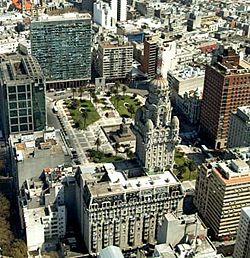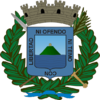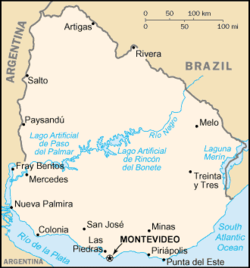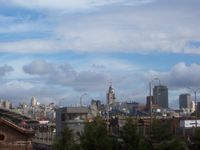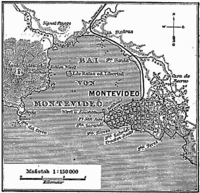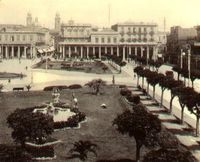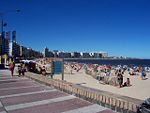Montevideo
2008/9 Schools Wikipedia Selection. Related subjects: Central and South America; Cities
| Montevideo | |||
| The Plaza Independencia, Independence Square. | |||
|
|||
| Motto: Con libertad ni ofendo ni temo With liberty I offend not, I fear not.] |
|||
| Coordinates: | |||
|---|---|---|---|
| Country | Uruguay | ||
| Department | Montevideo Department | ||
| Founded | 1726 | ||
| Founder | Bruno Mauricio de Zabala | ||
| Government | |||
| - Municipal Intendent | Ricardo Ehrlich | ||
| Elevation | 43 m (141 ft) | ||
| Population (2004) | |||
| - Total | 1,325,968 | ||
| - Rank | 1st | ||
| - Demonym | Montevideano | ||
| postal code | 10000 | ||
| Area code(s) | +02 | ||
| Website: www.montevideo.gub.uy | |||
Montevideo (IPA: [monteβi'ðeo]) is the largest city, the capital and chief port of Uruguay. Montevideo is the primate city in Uruguay, the only city in the country with a population over 1,000,000. Montevideo has a privileged harbour, one of the most important in the Americas. Also, it has beautiful beaches, like Pocitos, Buceo, Malvín, Playa de los Ingleses, Playa Verde, Punta Gorda and Carrasco. Many monuments and museums are found in the city, as well as historic buildings and squares. The city's mayor is Ricardo Ehrlich. According to Mercer Human Resource Consulting, Montevideo is the Latin American city with the highest quality of life (followed closely by Buenos Aires and Santiago de Chile).. It is the seat of the Roman Catholic Archdiocese of Montevideo.
Geography
Montevideo is situated in the south of the country, The geographic coordinates are 34.5° S, 56°W.
18 de Julio is the city's main avenue and extends from the Plaza Independencia, which is the junction between the Ciudad Vieja (the historical quarter) and the rest of the city, to the boundary between the neighborhoods of Cordón and Parque Batlle.
History
Origin of the name
There are at least two explanations for the name Montevideo: The first states that it comes from the Portuguese "Monte vide eu" which means "I see a hill". The second is that the Spaniards recorded the location of a mountain in a map as "Monte VI De Este a Oeste" meaning "The sixth hill from east to west". The city's full original name is San Felipe y Santiago de Montevideo.
Early history
The Portuguese founded Colonia del Sacramento in the 17th century despite Spanish claims to the area due to the Treaty of Tordesillas. The Spanish chased the Portuguese out of a fort in the area in 1724. Then, Bruno Mauricio de Zabala – governor of Buenos Aires – founded a military base there on December 24, 1726 to prevent further incursions. By 1730 the population increased and the military base got the right to have its own Cabildo (Town-Hall), which stimulated its growth. The first settlers arrived from the Canary Islands, brought by Francisco de Alzáibar. The city's first economic boom occurred when the Spanish Crown gave Montevideo the right to be the only slave port in the Viceroyalty of la Plata, which infuriated the Viceroyalty's capital, Buenos Aires.
In 1828, the town became the capital of Uruguay.
The city fell under heavy British influence from the early 19th century until the early 20th century as a way to circumvent Argentine and Brazilian commercial control. It was repeatedly besieged by Argentine dictator Juan Manuel de Rosas between 1838 and 1851. Between 1878 and 1911, British-owned railway companies built an extensive railway network linking the city and its port to the countryside.
20th century
During World War II, a famous incident involving the German pocket battleship Admiral Graf Spee took place in Punta del Este, 200 kilometres (120 mi) from Montevideo. After the Battle of the River Plate with the British navy and Royal New Zealand Navy on December 13, 1939, the Graf Spee retreated to Montevideo's port, which was considered neutral at the time. To avoid risking the crew in what he thought would be a losing battle, Captain Hans Langsdorff scuttled the ship on December 17. Langsdorff committed suicide two days later. On 10 February 2006, the eagle figurehead of the Admiral Graf Spee was salvaged. To protect the feelings of those still sensitive to Nazi Germany, the swastika on the figurehead was covered as it was pulled from the water.
Since 2005 the Mayor of Montevideo (styled Intendente Municipal in Spanish) has been Ricardo Ehrlich, of the Frente Amplio (Broad Front), gaining 61% of the vote in the Mayoral elections, beating Pedro Bordaberry of the Partido Colorado, who scored 27%.
Economy and demographics
Montevideo began as a minor settlement. In 1860, Montevideo had a population of 37,787. By 1884, the population had grown to 104,472, including many immigrants.
During the mid-20th century, a military dictatorship and economic stagnation caused a decline whose residual effects are still seen today. Many rural poor flooded the city, with a large concentration in Ciudad Vieja.
The current population estimates for Montevideo are 1,349,000 habitants in the city proper and 1,814,400 habitants in the greater metropolitan region.
Montevideans have European origins, with Italian and Spanish descent being the most common; however, there are also minorities of African origins and Jewish communities.
Montevideo's population makes up roughly 44% of the entire country of Uruguay. The surrounding department of Canelones, essentially Montevideo's suburbs and direct rural area, makes up another 12%.
Transport
Montevideo is served by Carrasco International Airport.
Neighborhoods
|
|
|
Culture
Montevideo has a rich architectural heritage and an impressive number of writers, artists, and musicians. Uruguayan tango is the form of dance that originated in the neighborhoods of Montevideo, Uruguay towards the end of the 1800s. Tango, candombe and murga are the three main styles of music in this city.
Sites of interest
- Centenario Stadium
- Salvo Palace
- Telecommunications tower
- Solis Theatre
- Palacio Legislativo
- Catedral Metropolitana
- Cabildo de Montevideo
